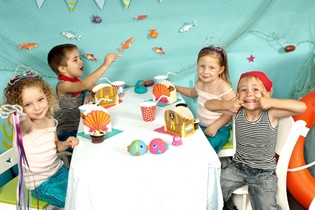Simple but effective discipline strategies

If your little cherub is more tearaway than treasure, fear not! Help is at hand in the form of simple but effective discipline strategies, writes psychologist Dr Melanie Woodfield.
Many psychologists believe that behaviour, whether it's "good" or "bad", doesn't exist in isolation. It's closely tied to what happened immediately before the behaviour and what comes immediately after the behaviour.
So you have a naughty wee rascal on your hands. First things first - we need to be very specific about defining the behaviour. A common request from parents is help with making their child "behave". This is a tall order, especially when neither the child nor the parent knows what "behave" means. The most helpful goals are SMART - Specific, Measurable, Achievable, Realistic, and Time-limited. This is a well-worn acronym that applies to goals for children, dogs, business people and athletes. An example of a SMART goal for a four-year-old might be to wash their hands every time they use the toilet.
Second, you need to work out whether you want to increase the behaviour or decrease it. You might want to increase teeth-brushing behaviour, but you might want to decrease hair-pulling behaviour. If you want to increase the frequency of something, adding reinforcement is the best bet - try a star chart. If it's decreasing behaviour you're after, you need to remove the reinforcement and/or add a consequence - try time-out or a natural or logical consequence.
Finally, you need to apply the intervention you've chosen, and do so in the most consistent way possible. Ideally, all adults in the child's life would be consistent. It might be worth explaining to the grandparents or daycare staff what's happening, so they don't accidentally undermine your attempts. Most importantly, don't underestimate the power of specific, well-timed praise.
THE NAUGHTY CHAIR
Poor old chairs, steps and corners were innocently minding their own business until Supernanny arrived on the scene - and suddenly they're naughty? Sending a child to sit on the naughty chair is just another form of time-out. There are lots of different ways of doing time-out; the important thing is that you choose one way and stick with it. The reason time-out works is that you're taking away any reinforcement for the behaviour you're trying to change. If little Suzy hits someone while playing, she's immediately (that's the key) asked to sit on the naughty chair, or to stand in the corner of the room, or whatever you've pre-arranged. This removes any positive consequences that might have been about to happen in the play situation. For example, hitting a child may have been about to score Suzy that child's toy, or to give Suzy some attention (even negative attention can be reinforcing). When an adult calmly but firmly places Suzy in time-out and ignores her tears and tantrums, the reinforcement isn't present and she's less likely to hit next time. It's essential that the time-out atmosphere is dull, boring and not reinforcing. If an adult spends 10 minutes pleading or chatting with Suzy it's not time-out - it's a tea party!
TOP TIPS FOR TIME-OUT
Many professionals suggest (as a guide) to use a minute of time-out per year of the child's age.
Try to be discreet. The older the child, the more important this is. If your child needs to be taken to time-out, take them quietly aside, rather than making a scene. If you embarrass or shame your child in front of their peers, they may resist you more, in order to "save face". The time-out place needs to be quiet, dull and safe. Sending a child to a bedroom full of toys is not time-out. Sitting in a hallway, a corner or a step is ideal. A bathroom (with access to cosmetics and chemicals) is not.
Be as specific as possible: "Hitting is not okay. If you hit you can't play with the others. You need to sit in the corner for six minutes. Off you go." Ignore tears and tantrums at this point, and firmly (but gently) escort your child to the corner.
Once your child has sat (reasonably) quietly for their time-out, briefy and clearly sum up the episode. The younger the child, the simpler this ought to be. For example: "Sally, hitting is not okay. Kids who hit don't get to play with others, so you came to sit in the corner for a little while. Good on you for sitting quietly. Off you go now and have fun with the others."
STAR CHARTS
A star chart usually consists of a wall-mounted poster or chart that lists a few specific behaviours that parents want to happen more often, along with spaces for stickers, smiley faces or ticks. Star charts work in exactly the opposite way to time-out, adding reinforcement instead of removing it. We use star charts to increase the frequency of a behaviour. A reward chart and tips can be downloaded from here.
Be as specific as possible with the behaviour you'd like to see more of. "Using a knife and fork" is better than "eating properly".
Try to phrase the behaviour in terms of what you'd like to see more of, rather than less of. For example, "using gentle hands with Jacob" instead of "stop hitting your brother".
Try to notice your child doing that particular behaviour and immediately take him to the chart and provide the reward. If this isn't possible, be sure to reinforce the behaviour by specifically praising it: "I noticed that you used gentle hands with Jacob - that's great. When we get home, we'll put a star on the chart. Make sure to remind me!"
NATURAL CONSEQUENCES AND LOGICAL CONSEQUENCES
A natural consequence is one that is likely to occur anyway. For example, a child, having been told not to run inside, trips over and stubs his toe. A child, having been told to take a jacket to kindy, gets rained on when he forgets. I'm not suggesting that we should allow our children to hurt themselves or catch pneumonia. However, many of us spend huge amounts of energy telling kids about natural consequences. Sometimes it's more powerful to allow them to safely experience them.
Logical consequences are similar but the difference is that the parent modifies the situation so that a consequence that fits with the original behaviour is allowed to happen. If a child throws a tantrum and refuses to eat his dinner, a logical consequence might be that he doesn't get any dessert or any more food that evening. If he refused dinner, he mustn't be hungry, so won't be given any more food. It's logical!
THE TECHNICAL BIT
The most effective consequences are:
Immediate: Put in place as soon as possible after the undesirable behaviour occurs.
Logical: Linked to the undesirable behaviour in some way. Sending a child to bed early for hitting his brother that morning is not immediate or logical. It would be more logical to remove the toy they were fighting about.
Consistent: Ideally, the same consequences are applied for the same undesirable behaviour every time it occurs.
Realistic: In frustration, sometimes we hear ourselves threatening a child with a consequence we both know is not going to happen - "If you do that again, I'll take all your toys away until your birthday!". With those sorts of consequences, we can end up shooting ourselves in the foot - taking kids' toys away could lead to bored, stroppy tots who are actually more of a headache!
The most effective rewards are:
Immediate: Reinforce or reward the desirable behaviour as soon as it occurs. Remember, specific, descriptive praise is a hugely effective reward that is portable - you'll never run out of praise but you might run out of stickers and lollies! Your child might seem oblivious to your praise but you can be sure it's noted.
Desirable: The reward or reinforcement needs to be appealing. Some parents worry they're "bribing" their child to comply by giving them praise and/or rewards. If that's the case, aren't we being bribed by money when we go to work? No, we're being rewarded for behaviour that is desirable to our employer. Remember that once your child is regularly displaying that desirable behaviour, you can slowly remove rewards and just praise them occasionally for the behaviour. Switch your attention to the next behaviour you want to see more of.
Want to learn more?
There are lots of courses available to support parenting. If you're keen for well-researched techniques that are effective and simple, try the Triple P - Positive Parenting Programme (www.triplep.net), or The Incredible Years (www.incredibleyears.com). Triple P has group and individual programmes for parents of children of all ages. The Incredible Years is designed for parents of three to eight-year-old children. It's delivered by different organisations throughout the country.
Dr Melanie Woodfield is a clinical psychologist in Auckland. She has two young boys who are constant recipients of psychological experiments. She also secretly loves Supernanny, especially the carefully edited "before and after" scenes!

AS FEATURED IN ISSUE 13 OF OHbaby! MAGAZINE. CHECK OUT OTHER ARTICLES IN THIS ISSUE BELOW














